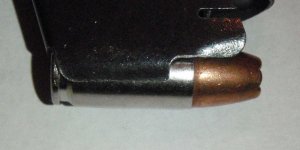I have a Hi-Point C9 (compact 9mm), and am having probs with rounds jamming while feeding from the clip. Actually, clips - two 10 rd and a 7 rd.
I figure that there are a set of common issues with this kind of thing in any semiautomatic. For instance, it appears that the clip lips play a very important part in how high the primer end of the cartridge sits and at what angle it lies in the top of the clip. All three are relatively new, and I had problems from the start with flat point ammo.
Well, I tried modifying the lips by experimenting with slightly bending them in or out. That didn't seem to help, and I resolved that the flat points were really the issue. I finally shot them all up and replaced them with standard round nosed ammo (extremely hard to find these days, it took months). So I go out target shooting today, and the same problem.
I could ask Hi-Point to replace them (and they would), but I figure I could have the same problem. I'd really prefer to know how to position the lips for optimum jam-free feeding for myself. Is there a rule of thumb to follow for measuring how far the round should sit at the top of the clip and the correct angle? Would slightly chamfering the lower lip of the chamber be something to try? I'd really appreciate any advice.
I figure that there are a set of common issues with this kind of thing in any semiautomatic. For instance, it appears that the clip lips play a very important part in how high the primer end of the cartridge sits and at what angle it lies in the top of the clip. All three are relatively new, and I had problems from the start with flat point ammo.
Well, I tried modifying the lips by experimenting with slightly bending them in or out. That didn't seem to help, and I resolved that the flat points were really the issue. I finally shot them all up and replaced them with standard round nosed ammo (extremely hard to find these days, it took months). So I go out target shooting today, and the same problem.
I could ask Hi-Point to replace them (and they would), but I figure I could have the same problem. I'd really prefer to know how to position the lips for optimum jam-free feeding for myself. Is there a rule of thumb to follow for measuring how far the round should sit at the top of the clip and the correct angle? Would slightly chamfering the lower lip of the chamber be something to try? I'd really appreciate any advice.



